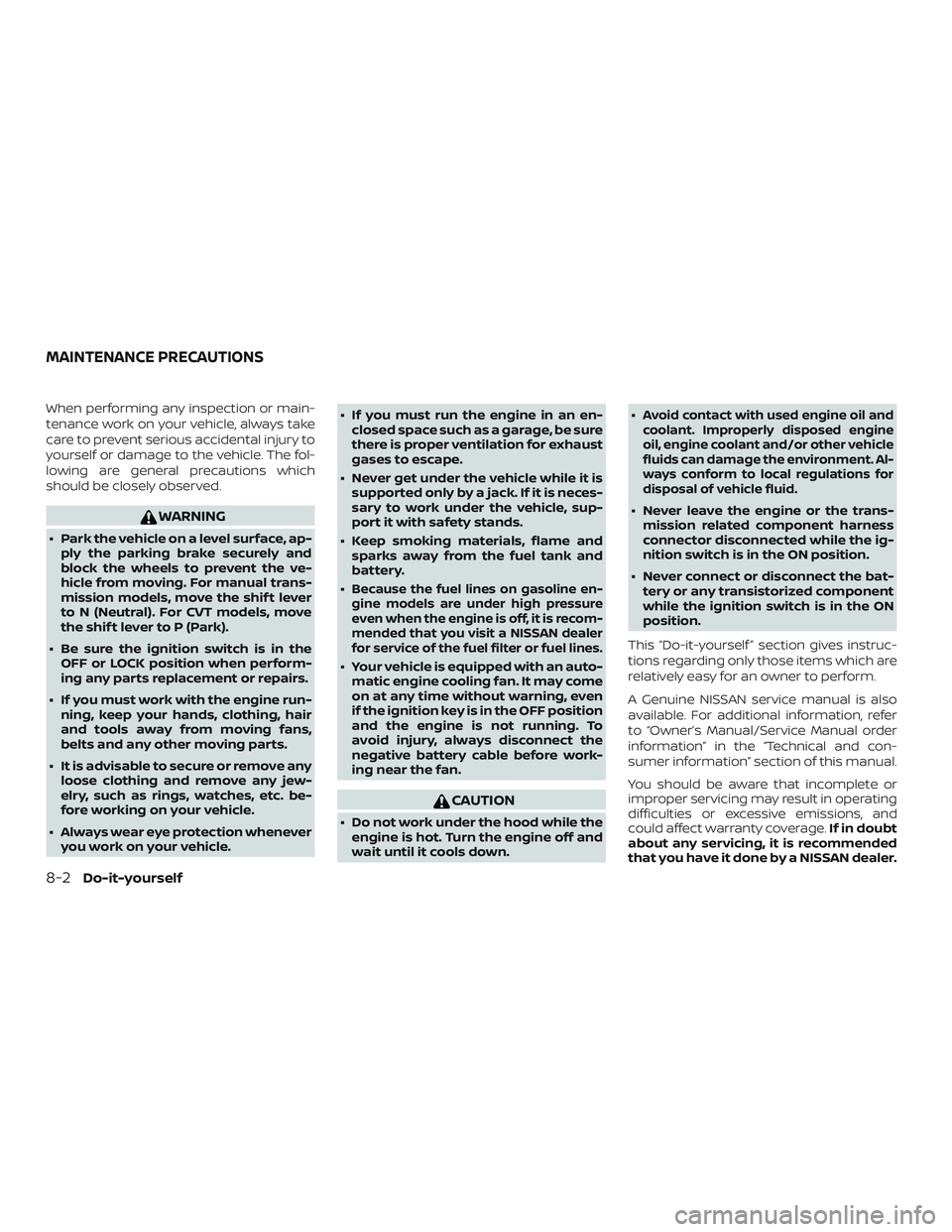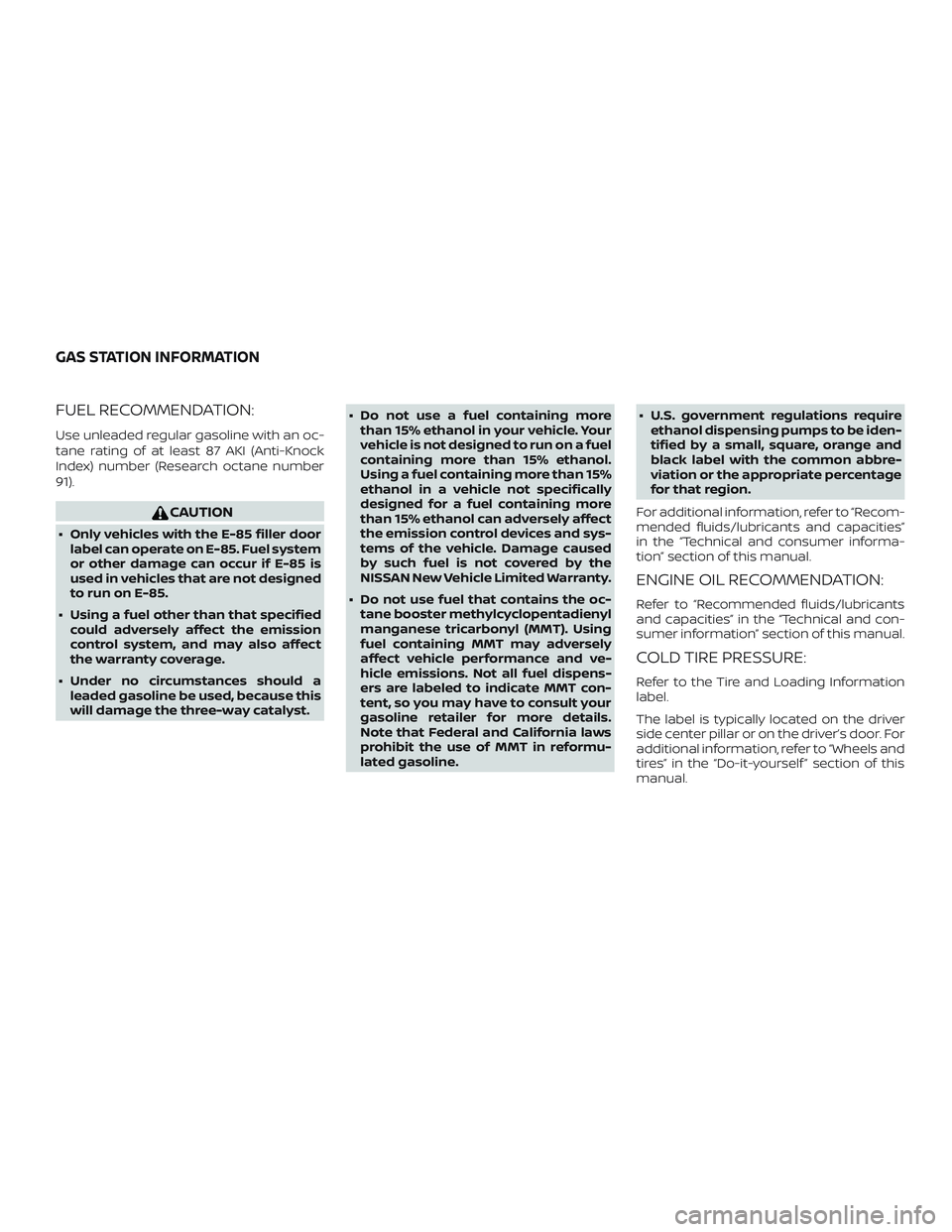2019 NISSAN VERSA SEDAN fuel pressure
[x] Cancel search: fuel pressurePage 282 of 372

When performing any inspection or main-
tenance work on your vehicle, always take
care to prevent serious accidental injury to
yourself or damage to the vehicle. The fol-
lowing are general precautions which
should be closely observed.
WARNING
∙ Park the vehicle on a level surface, ap-ply the parking brake securely and
block the wheels to prevent the ve-
hicle from moving. For manual trans-
mission models, move the shif t lever
to N (Neutral). For CVT models, move
the shif t lever to P (Park).
∙ Be sure the ignition switch is in the OFF or LOCK position when perform-
ing any parts replacement or repairs.
∙ If you must work with the engine run- ning, keep your hands, clothing, hair
and tools away from moving fans,
belts and any other moving parts.
∙ It is advisable to secure or remove any loose clothing and remove any jew-
elry, such as rings, watches, etc. be-
fore working on your vehicle.
∙ Always wear eye protection whenever you work on your vehicle. ∙ If you must run the engine in an en-
closed space such as a garage, be sure
there is proper ventilation for exhaust
gases to escape.
∙ Never get under the vehicle while it is supported only by a jack. If it is neces-
sary to work under the vehicle, sup-
port it with safety stands.
∙ Keep smoking materials, flame and sparks away from the fuel tank and
battery.
∙
Because the fuel lines on gasoline en-
gine models are under high pressure
even when the engine is off, it is recom-
mended that you visit a NISSAN dealer
for service of the fuel filter or fuel lines.
∙ Your vehicle is equipped with an auto- matic engine cooling fan. It may come
on at any time without warning, even
if the ignition key is in the OFF position
and the engine is not running. To
avoid injury, always disconnect the
negative battery cable before work-
ing near the fan.
CAUTION
∙ Do not work under the hood while theengine is hot. Turn the engine off and
wait until it cools down. ∙
Avoid contact with used engine oil and
coolant. Improperly disposed engine
oil, engine coolant and/or other vehicle
fluids can damage the environment. Al-
ways conform to local regulations for
disposal of vehicle fluid.
∙ Never leave the engine or the trans-
mission related component harness
connector disconnected while the ig-
nition switch is in the ON position.
∙ Never connect or disconnect the bat- tery or any transistorized component
while the ignition switch is in the ON
position.
This “Do-it-yourself ” section gives instruc-
tions regarding only those items which are
relatively easy for an owner to perform.
A Genuine NISSAN service manual is also
available. For additional information, refer
to “Owner’s Manual/Service Manual order
information” in the “Technical and con-
sumer information” section of this manual.
You should be aware that incomplete or
improper servicing may result in operating
difficulties or excessive emissions, and
could affect warranty coverage. If in doubt
about any servicing, it is recommended
that you have it done by a NISSAN dealer.
MAINTENANCE PRECAUTIONS
8-2Do-it-yourself
Page 362 of 372

LATCH (Lower Anchors and Tethers for
CHildren)System..............1-23
Precautions on child
restraints .........1-20, 1-27, 1-33, 1-38
Top tether strap anchor point
locations.................. .1-25
Child safety rear door lock ..........3-8
Chimes, audible reminders .........2-22
Cleaningexteriorandinterior......7-2,7-4
Clockset.....................4-5
Clutch Clutchfluid.................8-10
Coldweatherdriving.............5-35
Continuously Variable Transmission
(CVT) .....................5-9,5-16
Continuously Variable Transmission
(CVT) fluid ...................8-9
Driving with Continuously Variable
Transmission (CVT) ..........5-9,5-16
Control panel buttons .............4-3
Brightness/contrast button .......4-7
Controls Audio controls (steering wheel) .....4-43
Heater and air conditioner controls . .4-15
Coolant Capacities and recommended
fuel/lubricants...............10-2
Changing engine coolant .........8-5
Checking engine coolant level ......8-5
Engine coolant temperature gauge . .2-9
Corrosionprotection..............7-7
Cruisecontrol .................5-24
Cupholders...................2-32
Curtain side-impact and rollover air bag. .1-58 D
Defroster switch Rearwindowdefrosterswitch.....2-25
Dimensions and weights ...........10-9
Dimmer switch for instrument panel . . .2-27
Display controls
(see control panel buttons) ..........4-3
Door locks ..................3-5,3-6
Door open warning light ...........2-15
Drivebelt ....................8-14
Driving Cold weather driving ...........5-35
Driving with Continuously Variable
Transmission (CVT) ..........5-9,5-16
Driving with manual
transmission .............5-10,5-21
Precautions when starting and
driving.....................5-2
Drivingthevehicle...............5-16
E
Economy - fuel .................5-27
Emergency engine shutoff ..........5-13
Emission control information label . . . .10-11
Emission control system warranty . . . .10-18
Engine Before starting the engine ........5-14
Capacities and recommended
fuel/lubricants...............10-2
Changing engine coolant .........8-5
Changing engine oil ............8-7
Changing engine oil filter .........8-8
Checking engine coolant level ......8-5Checking engine oil level
.........8-6
Engine compartment check
locations...................8-3
Engine coolant temperature gauge . .2-9
Engine cooling system ..........8-4
Engine oil ...................8-6
Engine oil and oil filter
recommendation .............10-6
Engine oil pressure warning light ....2-15
Engine oil viscosity .............10-7
Engine serial number ...........10-11
Engine specifications ...........10-8
Starting the engine ............5-14
Engine coolant temperature gauge ....2-9
EventDatarecorders............10-20
Exhaust gas (Carbon monoxide) .......5-2
Explanation of maintenance items .....9-2
Explanation of scheduled maintenance
items .......................9-5
Extended storage switch...........8-21
F
Flashers
(Seehazardwarningflasherswitch)....6-2
Flattire....................6-2,6-3
Floormatpositioningaid...........7-6
Fluid Brakefluid..................8-9
Capacities and recommended
fuel/lubricants...............10-2
Clutchfluid.................8-10
Continuously Variable Transmission
(CVT) fluid ...................8-9
Engine coolant ...............8-4
11-2
Page 364 of 372

L
Labels Air conditioner specification label . . .10-12
Emission control information label . .10-11
Engine serial number ...........10-11
F.M.V.S.S. certification label ........10-11
Tire and Loading Information label . .10-12
Vehicle identification number (VIN) . .10-10
Vehicle identification number (VIN)
plate.....................10-10
Warning labels (for SRS) .........1-60
LATCH (Lower Anchors and Tethers for
CHildren)System............... .1-23
Launch bar menu ................4-7
License plate Installing the license plate .......10-12
Light Airbagwarninglight ........1-61, 2-19
Brakelight(Seestoplight)........8-27
Bulb check/instrument panel ......2-14
Bulb replacement .............8-27
Charge warning light ...........2-15
ExteriorandInteriorlights........8-27
Foglights..................8-26
Foglightswitch..............2-28
Headlight and turn signal switch ....2-25
Headlightcontrolswitch.........2-25
Headlights .................8-25
Interiorlight.............2-35,2-36
Lightbulbs.................8-25
Low tire pressure warning light .....2-16
Passenger air bag and status light. . .1-52
Security indicator light ..........2-21
Trunklight..................2-37 Warning/indicator lights and audible
reminders
..................2-19
Lights ......................8-25 Maplights..................2-36
Lock Child safety rear door lock ........3-8
Door locks ................3-5,3-6
Fuel-filler door lock opener lever . . . .3-29
Power door locks ..............3-7
Trunk lid lock opener lever ........3-27
Loose fuel cap warning ............2-7
Lowfuelwarninglight ............2-16
Low tire pressure warning light .......2-16
Luggage
(See vehicle loading information) .....10-13
M
Maintenance General maintenance ...........9-2
Insidethevehicle..............9-3
Maintenance precautions .........8-2
Outsidethevehicle.............9-2
Seat belt maintenance ..........1-17
Under the hood and vehicle .......9-4
Maintenance log ................9-13
Maintenance requirements ..........9-2
Maintenance schedules ............9-7
Maintenance under severe operation
conditions....................9-12
Malfunctionindicatorlight..........2-20
Manual front seat adjustment ........1-3
Manual windows ................2-35
Maplights....................2-36
Menu button ...................4-5 Meters and gauges
...............2-3
Instrument brightness control .....2-27
Mirror Outsidemirrorcontrol..........3-33
Outsidemirrors..............3-33
Rearview...................3-33
Vanitymirror................3-32
Mirrors......................3-33
N
NissanConnect® Owner's Manual ......4-2
NISSAN Intelligent Key® .........3-3,3-12
NISSAN Intelligent Key® battery discharge
indicator.....................5-13
NISSAN Vehicle Immobilizer
System ..................2-22,5-14
O
Octane rating (See fuel octane rating) . .10-6
Odometer ....................2-6
Oil Capacities
and recommended
fuel/lubricants...............10-2
Changing engine oil ............8-7
Changing engine oil filter .........8-8
Checking engine oil level .........8-6
Engine oil ...................8-6
Engine oil and oil filter
recommendation .............10-6
Engine oil viscosity .............10-7
Outsidemirrorcontrol............3-33
Outsidemirrors................3-33
11-4
Page 367 of 372

Vehicle Dynamic Control (VDC) system . .5-32
Vehicle identification.............10-10
Vehicle identification number (VIN) . . . .10-10
Vehicle identification number (VIN)
(Chassis number) ...............10-10
Vehicle identification number (VIN)
plate.......................10-10
Vehicle immobilizer system ......2-22,5-14
Vehicle loading information ........10-13
Vehiclerecovery................6-14
Vehicle security system ...........2-22
Vehicle security system (NISSAN Vehicle
Immobilizer System), engine start . .2-22, 5-14
Ventilators ....................4-14
Visors ......................3-32
Voice Prompt Interrupt ............4-50
W
Warning Airbagwarninglight ........1-61, 2-19
Anti-lock brake warning light ......2-14
Battery charge warning light ......2-15
Brakewarninglight............2-14
Door open warning light .........2-15
Engine oil pressure warning light ....2-15
Hazard warning flasher switch ......6-2
Loose fuel cap warning ..........2-7
Lowfuelwarninglight ..........2-16
Low tire pressure warning light .....2-16
Passenger air bag and status light. . .1-52
Seatbeltwarninglight.......1-13, 2-18 Supplemental air bag warning
light...................1-61, 2-19
Vehicle security system
.........2-22
Warning/indicator lights and audible
reminders ..................2-19
Warning labels (for SRS) .........1-60
Warning/indicator lights and audible
reminders ....................2-19
Audible reminders .............2-19
Indicatorlights...............2-19
Warninglights ...............2-19
Warninglights .................2-19
Warning lights, indicator lights and audible
reminders ....................2-13
Weights (See dimensions and weights) . .10-9
Wheels and tires .............8-31,10-9
Wheel/tire size .................10-9
When traveling or registering in another
country .....................10-10
Windows.....................2-33 Locking passengers' windows .....2-34
Manual windows ..............2-35
Powerwindows..............2-33
Rearpowerwindows...........2-34
Windshield-washer fluid ...........8-10
Windshield wiper blades ...........8-16
Wiper Wiper blades ................8-16
Wiperandwasherswitch..........2-24
11-7
Page 369 of 372

FUEL RECOMMENDATION:
Use unleaded regular gasoline with an oc-
tane rating of at least 87 AKI (Anti-Knock
Index) number (Research octane number
91).
CAUTION
∙ Only vehicles with the E-85 filler doorlabel can operate on E-85. Fuel system
or other damage can occur if E-85 is
used in vehicles that are not designed
to run on E-85.
∙ Using a fuel other than that specified could adversely affect the emission
control system, and may also affect
the warranty coverage.
∙ Under no circumstances should a leaded gasoline be used, because this
will damage the three-way catalyst. ∙ Do not use a fuel containing more
than 15% ethanol in your vehicle. Your
vehicle is not designed to run on a fuel
containing more than 15% ethanol.
Using a fuel containing more than 15%
ethanol in a vehicle not specifically
designed for a fuel containing more
than 15% ethanol can adversely affect
the emission control devices and sys-
tems of the vehicle. Damage caused
by such fuel is not covered by the
NISSAN New Vehicle Limited Warranty.
∙ Do not use fuel that contains the oc- tane booster methylcyclopentadienyl
manganese tricarbonyl (MMT). Using
fuel containing MMT may adversely
affect vehicle performance and ve-
hicle emissions. Not all fuel dispens-
ers are labeled to indicate MMT con-
tent, so you may have to consult your
gasoline retailer for more details.
Note that Federal and California laws
prohibit the use of MMT in reformu-
lated gasoline. ∙ U.S. government regulations require
ethanol dispensing pumps to be iden-
tified by a small, square, orange and
black label with the common abbre-
viation or the appropriate percentage
for that region.
For additional information, refer to “Recom-
mended fluids/lubricants and capacities”
in the “Technical and consumer informa-
tion” section of this manual.
ENGINE OIL RECOMMENDATION:
Refer to “Recommended fluids/lubricants
and capacities” in the “Technical and con-
sumer information” section of this manual.
COLD TIRE PRESSURE:
Refer to the Tire and Loading Information
label.
The label is typically located on the driver
side center pillar or on the driver’s door. For
additional information, refer to “Wheels and
tires” in the “Do-it-yourself ” section of this
manual.
GAS STATION INFORMATION